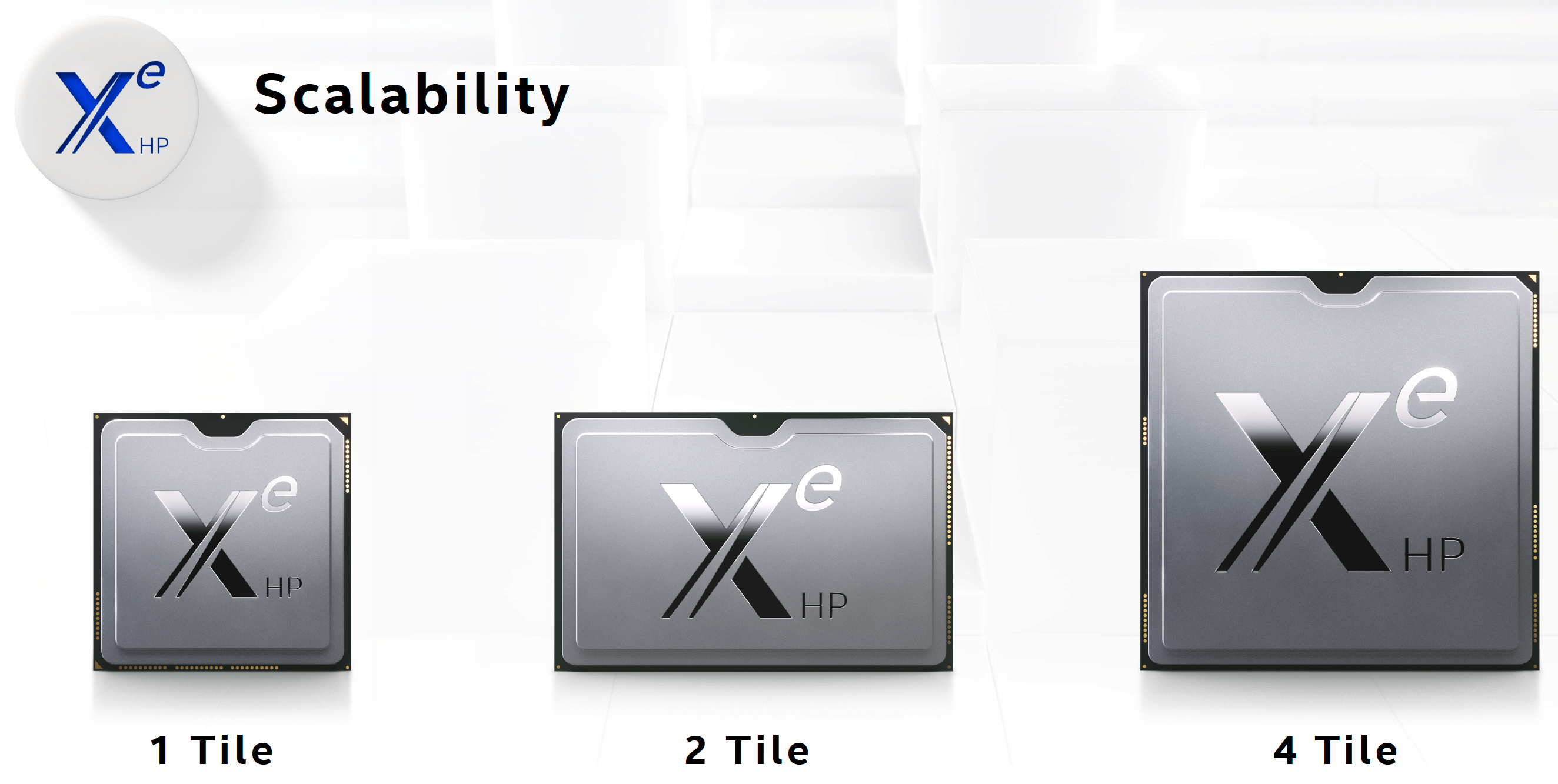Intel Cancels Xe-HP GPUs for Commercial Datacenters
Only available in the cloud.
Intel's Xe-HP compute GPUs were the company's first high-performance discrete GPUs in years to power on and were the first standalone Xe GPUs that Intel demonstrated to the public. But these GPUs will never make it to the market as the company decided to abandon this lineup. Instead, according to a tweet from Raja Koduri, senior vice president and general manager of the Accelerated Computing Systems and Graphics (AXG) Group at Intel, the company will concentrate on its Xe-HPG and Xe-HPC GPU families.
We deployed Xe HP in our oneAPI devcloud and leveraged it as a SW development vehicle for oneAPI and Aurora. We currently don’t intend to productize Xe HP commercially, it evolved into HPG and HPC that are on general market production pathOctober 28, 2021
The Xe-HP Family Axed
"We deployed Xe-HP in our oneAPI devcloud and leveraged it as a software development vehicle for oneAPI and Aurora," said Koduri. "We currently don't intend to productize Xe-HP commercially, it evolved into HPG and HPC that are on general market production path.
When Intel detailed its Xe family of GPU architectures in August 2020, it unveiled four architectures that were meant to power four product facilities: the Xe-LP for integrated and low-end discrete GPUs, the Xe-HPG for high-performance gaming graphics cards, the Xe-HP for commercial data center GPUs, and the Xe-HPC for supercomputers.

Xe-HP GPUs were meant to scale from one GPU tile to four GPU tiles and were supposed to power everything from cloud gaming to video streaming platforms and from virtual desktop infrastructure (VDI) to commercial accelerated computing.
To show off the potential of its Xe architecture in high-performance implementations, Intel demonstrated a quad-tile Xe-HP GPU in August 2020. That early Xe-HP GPU outperformed Nvidia's A100 compute GPU by double and offered performance of around 42 FP32 TFLOPS. The silicon was made internally using the company's 10nm Enhanced SuperFin (now called Intel 7) fabrication process, the same node that is used to make Intel's Alder Lake and upcoming Sapphire Rapids processors.

Intel's Xe-HP architecture relies on specialized execution units (EUs), high-bandwidth internal interconnects, and an HBM2E-based memory subsystem since these GPUs are (or rather were) designed to process vast amounts of data. These EUs support data formats and instructions common for data centers and high-performance computing (HPC), which includes FP64 for technical computing, bfloat16 for AI/ML workloads, DP4A convolution instruction for DL, and Intel’s new XMX instructions. In addition, Xe-HP has advanced media encoding/decoding capabilities to address video streaming services.
Missed Window of Opportunity?
Given the fact that Intel received its first Xe-HP GPUs from the fab in April 2020 and showcased them publicly in August, it probably planned to commercialize them by now. The company made its Xe-HP GPUs available to software designers back in November 2020 and earlier this year it shipped samples of these compute GPUs to developers.
Quite naturally, the company didn't disclose why it decided not to roll out its Xe-HP commercially, but we can speculate both about technological and strategical reasons.
Stay On the Cutting Edge: Get the Tom's Hardware Newsletter
Get Tom's Hardware's best news and in-depth reviews, straight to your inbox.
Configurations of Intel's Arctic Sound 2T samples for developers only included cards with up to 960 EUs over two tiles that were rated for 300W, which did not seem like the best combination of performance and power consumption.
While the FP32 performance of Intel's quad-tile Xe-HP looks impressive today, we do not know anything about its performance in other workloads and how it compares to the performance of existing hardware. Meanwhile, this product must be competitive for at least a couple of years and this is something that cannot be guaranteed given the fact that AMD is about to roll out its next-generation compute GPUs in November, whereas Nvidia is rumored to release its next-gen compute GPUs in 2022.
Timing may not be Intel's only problem with its Xe-HP GPUs. Back in the day, Intel addressed video streaming platforms like YouTube with Xeon processors or even special Visual Compute Accelerators (based on Xeons). Google's YouTube is replacing Intel's Xeon-based machines with servers running its homegrown visual (trans)coding units (VCUs), which could greatly shrink the addressable market for Intel's Xe-HP GPUs meant to replace Xeons and VCAs. If other major video streaming platforms follow the suit, the media transcoding capabilities of Xe-HP GPUs will hardly be appreciated. Meanwhile, media transcoding has always been a very important Xe-HPC component.
Or a Rational Decision?
On the other hand, Intel has its Xe-HPC-based Ponte Vecchio 'PetaFLOPS-class AI' compute GPU that appears to be performing better than expected. Being aimed at supercomputers, it cannot really address all types of datacenter workloads, but it can address loads of them, including technical computing that requires double precision as well as AI/ML. However, the caveat is that Ponte Vecchio is expensive to make. Yet, assuming that Intel can ship enough Ponte Vecchio compute GPUs to interested parties, launching a lower-cost rival for its own product isn't rational.

Intel is also about to introduce its Xe-HPG GPUs optimized for gaming. These parts can address desktops and laptops, but they can also be used to power cloud gaming services and provided that they support GPU visualization (ability to serve more than one client), they can be even better than Xe-HP. To serve gamers, Intel needs to offer a comprehensive software stack that is constantly updated to provide high performance in the latest games. Supporting a separate stack for Xe-HPG and Xe-HP GPUs is a hard and expensive task. Furthermore, Xe-HP GPUs are more complex than Xe-HPG GPUs since they have to support all the aforementioned HPC data formats and their combination of performance and power consumption may not be too attractive for cloud gaming services.
For the same reason, Xe-HP might not be too appealing to virtual desktop applications that need low power and relatively low cost.
But while Intel may have good reasons to ax Xe-HP family for now, it is still a bit disappointing to see this happening. Still, as Intel's discrete GPU initiative evolves, we may well see Intel's GPUs designed specifically for data centers.

Anton Shilov is a contributing writer at Tom’s Hardware. Over the past couple of decades, he has covered everything from CPUs and GPUs to supercomputers and from modern process technologies and latest fab tools to high-tech industry trends.
-
rtoaht It was always supposed to be a software development vehicle and stop gap for Ponte Vecchio. So not really cancelled. Now that Ponte Vecchio is performing better than expected there is no need for this.Reply -
escksu Yes, the real aim is ponte vecchio. Now intel even claim to be able to deliver a yottaflop supercomputer by 2027!! Thats 1000x faster than what we have today (1 exaflop is rare)... 6yrs is very small gap. Took us 10yrs to get from 1peta to 1exa.Reply -
JfromNucleon Reply
No, 1000x is a zettaflop iirc.escksu said:Thats 1000x faster than what we have today (1 exaflop is rare)
But I could be wrong -
Techspotsucks Replyevdjj3j said:They should go ahead and cancel the rest of them too.
Iol I was going to say the same thing exactly. -
Techspotsucks 1.) I have followed INTEL and AMD since I was a little kid back around 1990-1993 and this will be failure number 2 or 3. It seems to be a curse with INTEL trying to make GPU's.Reply
2.) I never really liked Raja when he started first at AMD's GPU team. I don't know why people over hype him, he's smart not special like Lisa Su. He's just over hyped and over paid for what he can dish out.
3.) Look at comment number one, INTEL needs to find a priest and maybe some holy water and lift this curse ;-) -
JayNor Ponte Vecchio compute tile and Xe-HPG are both built at tsmc. Looks like Xe-HPG architecture will get expanded to 4 tiles, which would include the ray tracing. Frees up more Intel-7 capacity for Sapphire Rapids and Alder Lake. Intel already has Meteor Lake compute tile on Intel-4, but I haven't seen an announcement for its GPU tile.Reply -
jaulia I suggest you to before use Intel Cancels Xe-HP GPUs first check the review about it. i suggest you to use LGA 1150 CPU Fastest, Mid Range, Flagship Generation, if you check review visit site.Reply
Click Here.